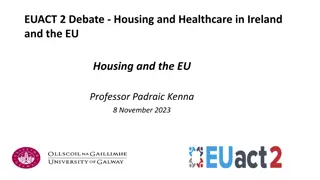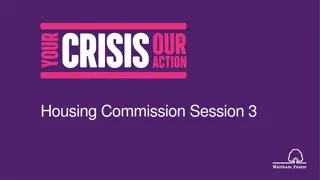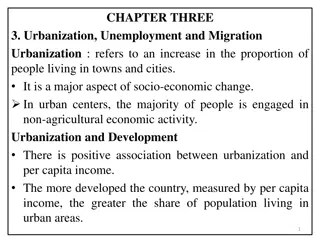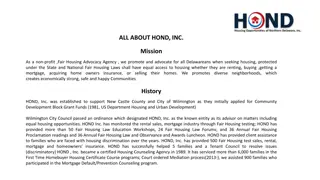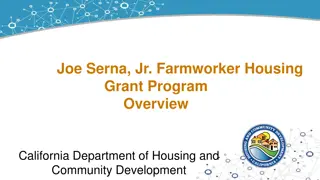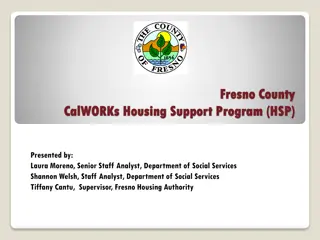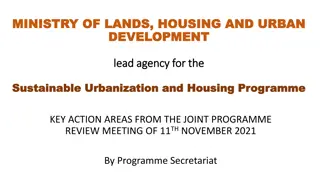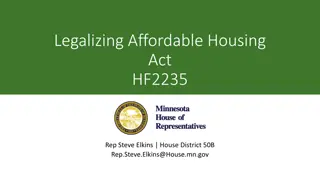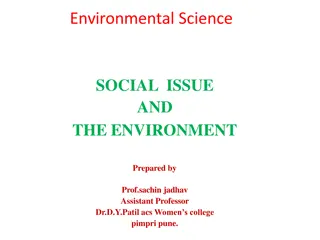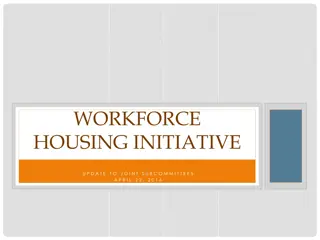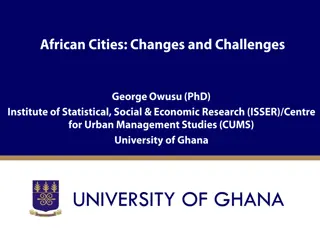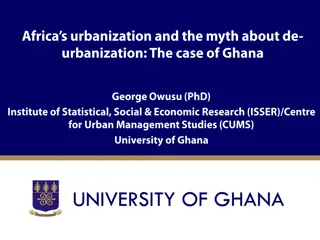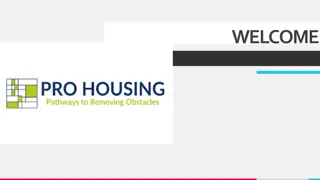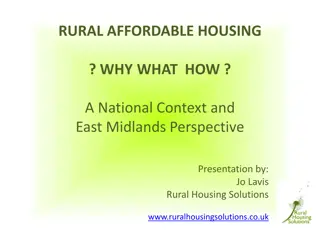Sustainable Urbanization and Housing Programme Overview
The Sustainable Urbanization and Housing Programme, part of the NDP III framework, focuses on addressing urbanization and housing challenges in Uganda. Led by the Ministry of Lands, Housing and Urban Development, the programme aims to reduce urban unemployment, housing deficit, improve infrastructure, and enhance solid waste management over the next five years. The Housing Sub-Programme, under the Directorate of Housing, plays a key role in formulating policies and strategies for housing development and management in the country.
Download Presentation

Please find below an Image/Link to download the presentation.
The content on the website is provided AS IS for your information and personal use only. It may not be sold, licensed, or shared on other websites without obtaining consent from the author. Download presentation by click this link. If you encounter any issues during the download, it is possible that the publisher has removed the file from their server.
E N D
Presentation Transcript
Sustainable Urbanization & Housing Programme PRESENTED TO THE URBANIZATION PRESENTED TO THE URBANIZATION & HOUSING PARTNERS GROUP & HOUSING PARTNERS GROUP By Programme Leadership & Secretariat By Programme Leadership & Secretariat
Quotes that reflects our approach If you want to walk fast, walk alone but if you want to walk far, walk with others & It s one small step for man, one giant leap for mankind.
Key Programme Background Information The Sustainable Urbanization and Housing Programme is one of the 20 programmes under the NDP III implementation framework. It is under the leadership of the Ministry of Lands, Housing and Urban Development which is responsible for offering policy guidance on Urbanization and Housing issues in the Country. The implementation of the National Development Plan III has adopted the programme approach to Planning and Budgeting, therefore the Sustainable Urbanization and Housing programme is mandated to guide the implementation of Urbanization and Housing interventions in the Country.
Expected Key Programme Key Results The SU&H Program has the following result areas for the next five years of NDPIII: The SU&H Program has the following result areas for the next five years of NDPIII: Decrease urban unemployment rate from 14.4 percent to 9.4 percent Reduce acute housing deficit of 2.2 million by 20 percent Decrease % urban dwellers living in slums and informal settlements from 60 percent to 40 percent Decrease the average travel time per km in GKMA from 4.1 min/km to 3.5 min/km Increase proportion of tarmacked roads in the total urban road network from 1,229.7 km (6.1 percent) to 2,459.4 km (12.2 percent) country wide Improve the efficiency of solid waste collection from 30% to 50%
HOUSING SUB PROGRAMME HOUSING SUB PROGRAMME
Sub Programme Background Information The Directorate of Housing formulates policies, legislation, procedures, housing standards and strategies that govern Housing Development and Estates Management in Uganda. It undertakes the development , implementation, monitoring and evaluation of housing programs; provides technical back up support; and oversees activities of housing developers and real estate agents as part of the mechanism to increase the quantity and quality of housing stock in the country.
Brief Situation analysis of Sub Programme Mandate The Housing and Real Estate sector in Uganda is one of the fastest growing sectors contributing 7.5 % to the National GDP and a key growth driver of the Ugandan economy. It is the second largest employer after agriculture. While the sector has been growing at a fast rate, the demand for decent affordable housing has remained higher than supply; particularly for low and middle income households. The increasing population and urbanization has not been matched by a corresponding increase in the stock of affordable housing. The country s housing backlog currently stands at 2.1 million units (NDP III); and is projected to grow to 8 million units by 2030. Currently over 60% of Uganda s urban population live in slums. Whereas the annual need for new housing for the entire country is estimated at 200,000; only 60,000 (30%) reasonably good houses are constructed annually in both rural and urban areas (National Housing Policy, 2016).
Expected Key Sub Programme Results 1. 2. 3. 4. 5. Develop Real Estate law to regulate the Real Estate Sector. Amend the Architects Registration Act , CAP 269 Develop comprehensive public -private partnership housing program. Conduct housing needs Assessment for new cities and hard to reach districts . Prepare and disseminate free, low-cost house Prototype plans in all districts to vulnerable groups including the poor, elderly, PWDs, women to support access to decent, affordable housing. Conduct sensitization on the National Building Code (2019) including Accessibility Standards for the Disabled in all districts. Promote energy efficient, green building design in buildings in all districts to mitigate impact of climate change 6. 7.
Proposed Sub Programme Critical areas of collaboration with Partners 1) Establish a housing and real estate information system. 2) Establish Mortgage Refinance Company to increase affordability of Mortgages. 3) Promote housing rights. 4) Promote research and adoption of cheap, alternative building technologies. 5) Mainstream climate change mitigation in housing and building sector. 6) Undertake Slum upgrading and redevelopment of informal settlements. 7) Develop affordable housing estates for cities and municipalities for low and middle income groups. 8) Promote and sensitize the public on building development procedures, standards and real estate laws.
Housing Sub Programme requirements to address the critical areas of collaboration i. ii. iii. Housing finance deepening. iv. Land. v. Training and Capacity building. vi. Research. vii. Technical Support. viii. Establish a low cost housing technologies Centre. ix. Housing finance deepening. Finance. Feasibility studies.
Housing Sub-Programme Challenges 1. Low prioritization of the sub sector in national plans and budgets leading by Low Funding in national budget. Whereas sector contributes 7.5% to GDP, the current allocation in the budget to the housing sector is app 0.3% leading to: Low impact since only a few of the planned activities can be implemented. Limited research to inform sector activities. 2. Weak affordable housing enabling framework for Private Sector. e.g. Several projects have aborted due to the lack of guarantees, subsidies etc to investors in mass housing development. 3. Weak institutional framework for housing delivery. There is need to review and support the mandate NHCCL and HFB.
Suggested Solutions to the challenges 1. Increase prioritization of the Sub Programme Interventions in national and partner plans and budgets 2. Mobilize foreign and partner investments and support into Housing Sub Programme 3. Strengthen affordable housing enabling framework to enable the Private Sector to develop low income housing. 4. Strengthen institutional framework for Housing delivery.
PHYSICAL PLANNING AND PHYSICAL PLANNING AND URBANIZATION SUB URBANIZATION SUB PROGRAMME PROGRAMME
Sustainable Urbanization A collective responsibility
Key Sub Programme Background Information Urbanization offers opportunities for accelerating socio-economic transformation. Its contribution manifests in the improvement of incomes and quality of the population through increased productivity, inclusiveness and well-being of the population. SU&H Program will contribute to global Agenda 2030 for Sustainable Development (SDG11), as well as the Africa Agenda 2063 However, Uganda s current urban growth and development pathway is yet to be seen as sustainable. The goal of this program is to attain inclusive, productive and liveable urban areas for socio-economic development
Brief Situation analysis of Sub Programme Uganda is urbanizing rapidly, estimated at 27% Urban growth rate at 5.2 % p.a, implying 35 percent of Uganda s population will be urban by 2030. During the 10-year (2020-2030) plan period alone, Uganda s urban population is projected to grow by 69%, adding an est. 8.1 million people to the country s urban areas alone. Uganda s rapid urbanization can foster the transition to a middle-income country, if it is planned well. An estimated 70% of GDP can be generated in Uganda s urban areas, where only 24.4 %of the population lives. An estimated 70% of GDP can be generated in Uganda s urban areas, where only 24.4 %of the population lives. If Uganda s growing cities and the national urban system are to play a central role in economic transformation, the binding constraints and opportunities therein should be addressed to increase productivity and create jobs in the urban areas.
Sub Programme Overall Goal Over the NDPIII period, focus on harnessing the urbanization potential will be on: (i) fast tracking sustainable urbanization; (ii) building capacities of urban centres to manage the rapid urbanization; (iii) building the requisite infrastructure and housing for urbanization; (iv) fast-tracking industrialization for urban centres; (v) planning and diversifying the country s urban centres; and (vi) greening Uganda s urbanization process. Key to note- Urban Housing has a multiplier effect on industrialization through supporting of 40 local Industries
Key Result Area 1 Decrease the urban unemployment rate from 14.4 percent to 9.4 percent; What is 14.4% and 9.4% in terms of numbers and categories of unemployment The numbers and category will help determine the jobs needed The program indicates 15,326 human resource requirements in different skill sets- Link these skill sets to the number of the jobs
Key Result Area 2 Reduce the acute housing deficit of 2.2 million by 20%; 20% of 2.2M = 440,000 Homes built in a planned environment and with all attendant infrastructure ie economic, commercial, social and recreational amenities Who will build these homes; Private sector, PPP s, self build?
Key Result Area 3 Decrease the percentage of urban dwellers living in slums and informal settlements from 60 % to 40%; Total Urban Population est.11 M (UBOS 2020) 60% of 11M is in Slums = 6.6M and 40% of 6.6M = 2.64M Considering a Household per capita of 4 persons in Urban Areas translates into 330,000 Homes per city Each of these 30000 units will require building costs at current market prices, with added cost of attendant infrastructure est. at 50%
Key Result Area 4 Decrease the average travel time per km in GKMA from 4.1 min/km to 3.5 min/km; Invest in mass transit Infrastructure for; Non-Motorised Transport services and Infrastructure Trams, Light Rail, BRT to provide alternatives to Minibuses and Private Cars Invest and operationalize an efficient public transport system within and across cities
Key Result Area 5 Increase the proportion of tarmacked roads in the total urban road network from 1,229.7 km (6.1%) to 2,459.4 km (12.2 %); N.B Cost per Km is estimated at UGX 20Bn for a functional urban street that includes 7M Vehicular lane, 3M segregated bike & 3M walking lane, 2M tree lane, underground utility and services ducts, street lights and 3M parking space What is the current budget and where will these roads be constructed?
Key Result Area 6 Improve the efficiency of solid waste collection from 30% to 50 % Investment in solid waste infrastructure for the regional cities and to serve the city region Promote the 5Rs in solid waste management Invest in Mindset Change for communities to treat waste as a resource Put in place punitive measures and and incentivize wastes efficient waste management practices.
Proposed Sub Programme Critical areas of collaboration with Partners 1 1 Prepare and implement 15 cities Integrated Development Plans Prepare and implement 15 cities Integrated Development Plans 2. Develop Green, economic and social infrastructure and systems for Cities 3. 2. Develop Green, economic and social infrastructure and systems for Cities 3. Develop social and institutional Housing including slum re Develop social and institutional Housing including slum re- -development development 4. Establish a Special Purpose Vehicle for Financing and Development of Cities 4. Establish a Special Purpose Vehicle for Financing and Development of Cities 5. Investment in integrated development plans with bankable projects for urban 5. Investment in integrated development plans with bankable projects for urban infrastructure infrastructure
Requirements to address the critical areas of collaboration 1. Review policy, regulatory and institutional framework for financing, management and governance for cities and other urban areas 2. Build technical capacity at national and sub-national level 3. Secure funding for infrastructure Development for the 10 operational cities. 4. Effectively conduct oversight, monitoring, evaluation and inspection of policies and sub programs and projects 5. Implementation of the PPP strategy in the 10 operational regional cities
Other suggested areas of collaboration in future Partnership Financing of urban infrastructure and investments ($30 Partnership Financing of urban infrastructure and investments ($30- -50 Bn) required annually Bn) required annually 50 Investment in Technology Transfer Investment in Technology Transfer Bankable projects and implementation of individual city investment Bankable projects and implementation of individual city investment profiles profiles Corporatization of Cities Corporatization of Cities
Sub Programme Achievements to-date Dissemination of National Urban Policy. Technical support supervision in physical planning, Land-use regulatory framework and urban development practices Review the National Physical Planning Standards and Guidelines Two District Physical Development Plans prepared Plans for some cities prepared/being prepared (Soroti, Fort Portal, Kitgum, Kabale, Entebbe, Jinja, .) Achievements of the USMID program (infrastructure, capacity building, planning, revenue generation, etc ) Prepared, and disseminated free, low-cost prototype plans selected districts Prepared, and disseminated guidelines for energy efficient, green building design and energy efficiency in buildings in four selected districts
Sub Programme Challenges Low capacity by urban authorities (personnel (numbers & skills), financial, tools, etc Inadequate funding for urban infrastructure and investments
Suggested Solutions Innovative planning approaches . In house planning, for example, capacity building for planning that works Pre-investment resourcing and financial enhancement: Secure pre-investment resources to help the Ministry and the new cities improve the preparation of project initiatives and structure financial arrangements to effectively access the financial markets. Identify sources of financing for the pre-investment of urban infrastructure, including resources for the preparation of climate-smart infrastructure projects. City credit worthiness financing facility: Develop and implement a facility to deliver technical assistance to aid the new cities improve their financial performance and creditworthiness. Private sector participation: Support private sector participation in the provision of urban infrastructure and services using appropriate public and private finance instruments. Innovative financing vehicles are needed for leveraging private sector engagement. Promote innovative financial transactions conducive for private sector investment, viable PPPs, and strengthening of local financial markets.
Sub programme Conclusion Government needs at least $40-50 Billion in investment annually to meet the programme targets. Conventional approaches of securing large sums of finances are inadequate Creative financing approaches have to be undertaken. The Government in partnership with private sector and development partners should focus on organizing Uganda s urbanization opportunities to make it attractive to large institutional investors around the world. The Government must put in place attractive financing mechanisms to benefit from the available local and foreign investment funds
GREATER KAMPALA GREATER KAMPALA METROPOLITAN AREA METROPOLITAN AREA (GKMA) (GKMA)
The GKMA-EDS 5 Thematic areas Competitive economic Competitive economic infrastructure infrastructure Conserve and protect Conserve and protect environmental assets environmental assets Business support to Business support to transform the informal transform the informal sector, the youth and sector, the youth and economic clusters economic clusters A unique center for A unique center for tourism tourism Effective city and local Effective city and local government service government service delivery delivery
MoKCC&MA-Key Institutional and Policy Reforms I. Enactment of the KCC Act 2010 II. MKCC established under Office of the President III.Amendment of The KCC Act in 2020 (section 26) IV.MKCC&MA mandate expanded to include physical planning V. GKMA-Economic Development Strategy developed VI.GKMA-EDS approved by cabinet in march 2020 under 132 (CT2020) 34
GKMA-Urban development Program (GKMA-UDP) NDPIII Programme GKMA-UDP (Project) Goal SNo. To increase the stock, quality and inclusive transport infrastructure to connect people to jobs and improve private sector competitiveness in GKMA Integrated Infrastructure and services Transport GKMA-Integrated Transport Development Project 1 GKMA-Job private sector development Project creation and Private Development Sector To increase decent and inclusive job opportunities through promotion of private sector growth in GKMA 2 Sustainable Urbanization and Housing Affordable housing and slum upgrading project To contribute to attaining inclusive, productive and livable urban areas for socio-economic transformation in GKMA 3 Public Transformation programme Sector MoKCC&MA retooling & GKMA strengthening project To strengthen the capacity of GKMA entities and the ministry of Kampala capital city and Metropolitan Affairs to deliver efficient and effective services and its expanded mandate institutional 4 Environment, resource management programme Natural land GKMA-Climate Change and Drainage Improvement Project To enhance the drainage infrastructure in the GKMA so as to reduce losses of livelihood, life and property due to flooding Water 5
GKMA prevailing Challenges i. Degradation of the environment and natural resources due to human activities. i. Informality development hence limited business ii. The negative impact of climate change on rainfall patterns. ii. High cost of doing business such as limited cost to financing, high utility costs, legal requirements, workspaces, management inadequate entrepreneurial skills and poor work ethics. iii. High concentration of settlements in flood-prone areas in GKMA. financial iv. Poor waste management practices, such as: dumping of wastes leading to blockages of drainage channels. v. Inadequate capacity of the existing drainage infrastructure to handle the run-off. iii. Rural urban migration vi. Human influences i.e. poor drainage design and inadequate enforcement of planning regulations, iv. Skills mismatch in the job market. vii. Poor Operation and maintenance of existing drainage channels v. Lack of skills for most youth
GKMA prevailing Challenges i. Poor transport network planning ii. Limited capacity and resources for infrastructure development and maintenance iii. Lack of efficient alternative modes of public transport iv. Noncompliance to regulation coupled with poor enforcement v. Jurisdiction coordination challenges amongst MDAs. vi. Increasing traffic volumes as a result of increasing urban population vii.Poor land use management resulting to factors like floods and storm water
Proposed GKMA Sub Programme Critical areas of collaboration with Partners i. Improve mobility, connectivity and accessibility in GKMA ( reduce Travel time from 4.10 to 3.5min/km) ii. Upgrade and improve access to social services in GKMA slums iii. Safe waste management in GKMA iv. Resilience and drainage Improvement - reduce flooding in GKMA
Requirements to address the critical areas of collaboration Proposed area for collaboration Critical bankable project/ solutions i) Construction/upgrading of strategic connectivity roads that can decongest and divert traffic ( GKMA has only 27% of its road network tarmacked) Improve mobility, connectivity and accessibility in GKMA ( reduce Travel time from 4.10 to 3.5min/km) ii) Water transport (Mukono-Ggaba-Entebbe) iii) Cable Car pilot iv) Bus rapid Transit (BRT)
Requirements to address the critical areas of collaboration Proposed area for collaboration Critical bankable project/ solutions i) Development of an Integrated GKMA solid waste management Strategy ii) Development of Dundu land fill for all GKMA entities iii) Construction of waste Transfer Facilities in all GKMA Entities iv) Constriction of Recycling Plants at Transfer Facilities for production of by products v) Procurement of 64 waste trucks for GKMA entities (each with entity with 8 trucks) vi) Construction of waste to energy facility at kitezi, Nkumba, Dundu Safe waste management in GKMA i) development of an integrated Drainage master Plan for GKMA ii) Widening and Construction of the 31 drainage channels in GKMA (Primary and Secondary) iii) Increase the Greening infrastructure and urban eco-tourism iv) Demarcation and restoration of wetlands and buffers In GKMA v) Upscale air quality monitoring vi) Disaster and Early warning equipment for GKMA vii) Urban Forestry (fruit and medical tree planting and beautification ) Protect and environmental assets
Requirements to address the critical areas of collaboration Proposed area for collaboration Critical bankable project/ solutions i) Upgrade and improve access to social services in GKMA slums (kinawataka, kasokoso, kajjansi-line, namuwongo, Bwaise) ii) Feasibility studies and Designs for GKMA slums iii) Pilot affordable Housing project in GKMA Slum upgrading i) construction markets in GKMA to provide workspaces for women and youth ii) Construction of 3 modern abaittor (fresh meet, bio energy, fertilizer generation) along Entebbe road, Jinja road, Hoima road iii) Incubation and Innovation hubs for product development iii) Construction of Lunyo IPO center in Entebbe iv) Construction of The MICE center (Meetings, Incentives Conferences and events center) to v) v) promote Cultural, religious and eco-tourism exhibitions vii) Apprentice skilling for youth viii) Improve works spaces access to services by agro-pocessing zones ix) Incentives for private sector to thrive Job creation and support to private sector
Programme requirements to address the critical areas of collaboration Capacity Development, Technical and skilling support to improve the capacity of the programme team to deliver on their mandate In kind and financial support to upscale the implementation of programme interventions Organize exchange and study visits and interactions between programme implementers and partner Countries for sustainable development Technological transfer and practice opportunities to the programme implementation team Specialized trainings deemed vital for the effective implementation of programme activities Support to Research and Development to better understand and articulate programme development concerns
Overall Programme Challenges Underfunding of programme activities, this is likely to affect the effective implementation of programme targets thus inability to achieve key programme results Limited skills and staff capacity to effectively implement programmed interventions under the Sustainable Urbanization and Housing programme Limited physical planning coverage (6/137 LGs) in the Country affects sustainable development both in urban and rural set ups Huge Housing backlog of over 2.3million houses affects the productivity of the population thus impacting on the economic development of the Country
Conclusion Chair, We sincerely thank you for the opportunity given to us to share our proposed critical areas of collaboration with the members of the Urban Development Partners Group (UDPG) and look forward to further engagements with you for the realization of the key results under the Sustainable Urbanization and Housing programme. It is our sincere hope, that with the synergies and continued collaboration with the Urban Development Partners Group, the programme will be able to achieve it s objectives and expected results as articulated in the NDPIII framework.



